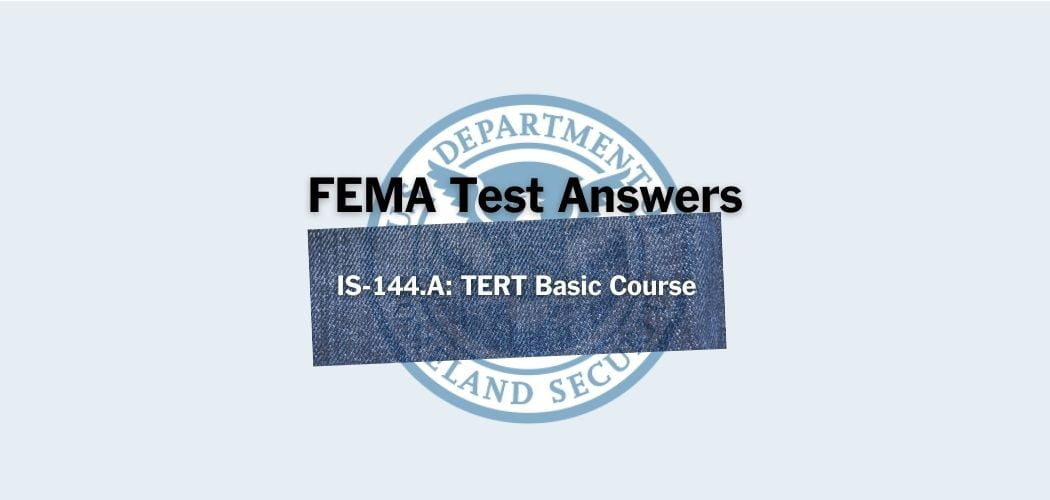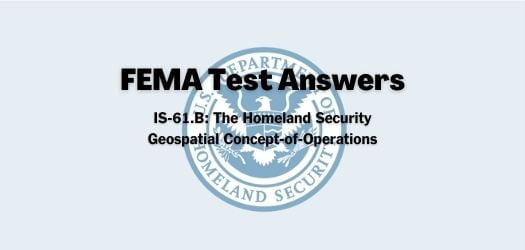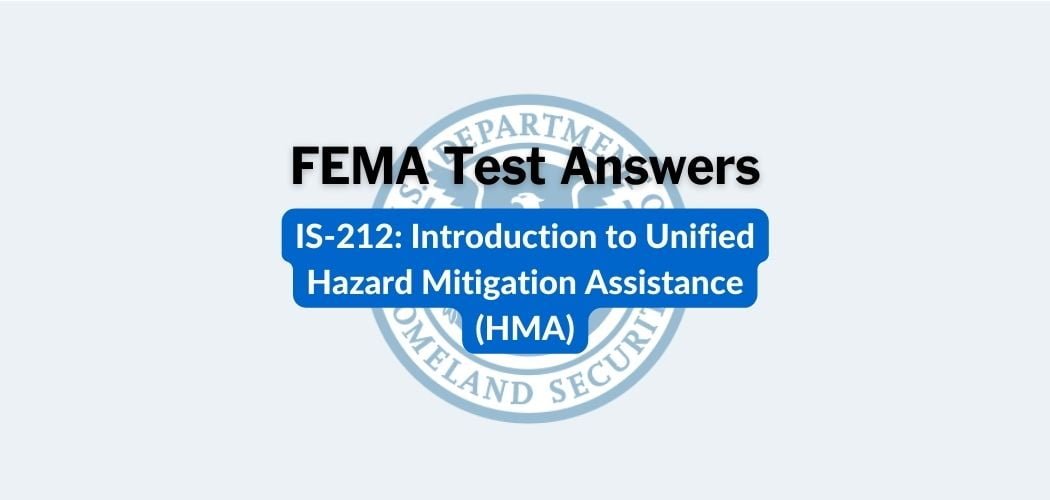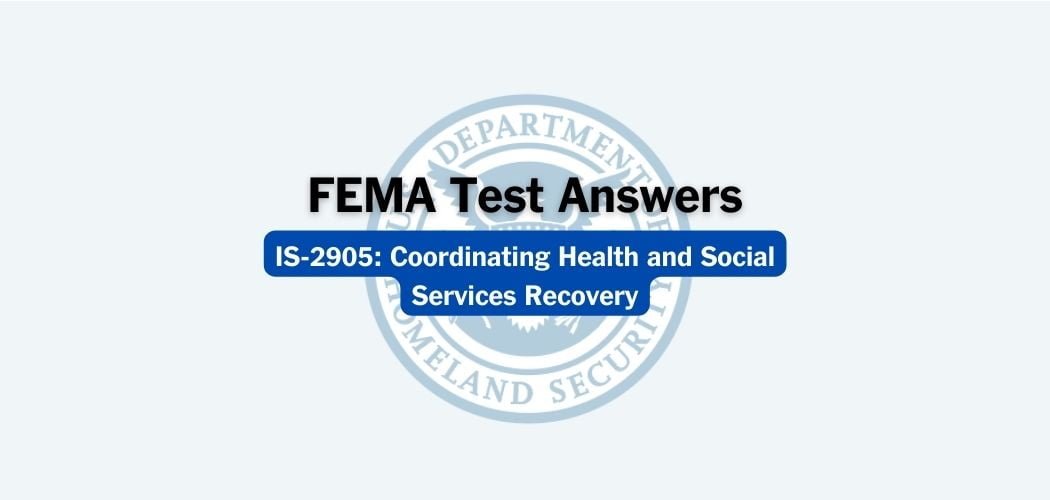Overview: The FEMA IS-1108 course was published on 9/2/2015 to review the different ways that condominiums can be written in the NFIP and what makes condominiums unique — in other words, what sets them apart from other building types that are written in the National Flood Insurance Program.
Primary audience: The IS-1108 course is for all NFIP Insurance Agents. Rich Slevin of NFIP Training will lead you through a series of video segments covering topics relevant to condominiums in the NFIP.
FEMA IS-1108 test answers
Each time this test is loaded, you will receive a unique set of questions and answers. The test questions are scrambled to protect the integrity of the exam.
Question 1. Low-rise buildings generally have a greater percentage of the building’s value at risk than high-rise buildings.
A. TRUE
B. FALSE✅
Question 2. When can a condominium association purchase a Preferred Risk Policy?
A. When it is for a building such as a clubhouse or recreational building in Zone V
B. When it is for a building insured under the RCBAP and located in a low — or moderate—risk flood zone
C. When it is for an individual unit owned by the association in Zone X
D. All of the above✅
Question 3. How often must the agent update the Replacement Cost Value of a residential condominium building written on the RCBAP?
A. Every year
B. Every 3 years✅
C. Every 5 years
D. The frequency is at the agent’s discretion, depending on the real estate market.
Question 4. Part of the Shubert Condominium complex includes a theater and concert hall building. Under what form should the policy for this building be written?
A. Dwelling Form
B. General Property Form✅
C. RCBAP
D. The structure could be written under any of these forms.
Question 5. Arthur Werner suffers $88,000 of flood damage to his condominium unit. He has $100,000 of Personal Property coverage on his SFIP. What percentage of that Personal Property coverage limit can he apply to damage to any additions and alterations he has made to his unit?
A. 5%
B. 10%✅
C. 15%
D. 20%
Question 6. Which of the following statements apply to low-rise buildings?
A. They must have less than five units, regardless of the number of floors, or five or more units with less than three floors.
B. They must have five or more units and at least three floors.
C. An enclosure below an elevated building cannot be counted as a floor, even if it is the lowest floor for rating purposes.
D. The basic limit rate is the first $60,000 worth of building coverage for each unit.
E. A and B
F. A and D✅
Question 7. Which building type has the availability of optional higher deductibles: low-rise buildings or high-rise buildings?
A. Low-rise buildings
B. High-rise buildings
C. Both✅
D. Neither
Question 8. What is the maximum Coverage A – Building Property coverage limit under the Dwelling Form?
A. $50,000
B. $100,000
C. $250,000✅
D. $500,000
Question 9. Which SFIP form has an Increased Cost of Compliance limit of $30,000?
A. Dwelling Form
B. General Property Form
C. RCBAP
D. All of the above✅
E. None of the above
Question 10. The RCBAP covers loss assessments levied against a condominium association to cover the cost of a coinsurance penalty.
A. TRUE
B. FALSE✅
Question 11. Which SFIP form has a coinsurance penalty?
A. Dwelling Form
B. General Property Form
C. RCBAP
D. The SFIP does not have a coinsurance penalty.
E. Both B and C✅
Question 12. Which of the following statements apply to high-rise buildings?
A. The basic limit rate is $175,000 of building coverage, regardless of the number of units in the building.
B. They must have five or more units and at least three floors.✅
C. They include townhouses and row houses.
D. The basic limit rate is the first $60,000 worth of building coverage for each unit.
E. A and B
F. A and C
Question 13. Which of the following are typical responsibilities of the condominium association’s board of directors?
A. Maintenance and operation of the condominium building
B. Ensuring the common property is insured against hazards
C. Maintaining the condition of each unit owner’s improvements and betterments
D. A and B✅
E. A and C
F. All of the above
Question 14. What is the maximum Coverage B – Personal Property coverage limit for a commercial condominium building?
A. $100,000
B. $250,000
C. $500,000
D. $750,000✅
E. $1,000,000
Question 15. What is the maximum Coverage A – Building coverage limit for a commercial condominium building?
A. $100,000
B. $250,000
C. $500,000
D. $750,000
E. $1,000,000✅
Question 16. Which of the following applies to all three SFIP forms?
A. Separate deductibles for building and contents
B. Federal policy fee✅
C. Reserve Fund Assessment
D. A and B
E. All of the above
F. None of the above
Question 17. An individual unit owned by the condominium association may be separately insured if the policy is purchased by the association.
A. TRUE✅
B. FALSE
Question 18. The Pleasant Grove Condominium’s clubhouse should be insured under the RCBAP because it is common property.
A. TRUE✅
B. FALSE
Question 19. Which term matches the following definition: a form of ownership of a dwelling unit within a multi-dwelling building
A. Building association
B. High-rise building
C. Condominium✅
D. Low-rise building
Question 20. What percentage of the total floor area must be residential in order for a condominium building to be written under the RCBAP?
A. 25%
B. 50%✅
C. 75%
D. 100%
Question 21. Sarah Aiello just bought a residential condominium unit and wants to insure her personal property in the unit. Under which form should the Personal Property coverage be written?
A. RCBAP
B. Dwelling Form
C. HO6 Form✅
D. General Property Form
Question 22. The White Sands Condominium building suffered damage due to a flood. The cost of repairs to the main lobby furniture and gym equipment on the first floor — property owned in common — was $360,000. How much of this damage could be covered under RCBAP’s Coverage B. Personal Property?
A. $100,000✅
B. $250,000
C. $500,000
D. $750,000
Question 23. Under which SFIP form should a residential condominium building used as a hotel or motel, or being rented either short or long term be insured?
A. Dwelling Form
B. General Property Form✅
C. RCBAP
D. This is a trick question; hotels and motels cannot be insured under the SFIP.
Question 24. Under which SFIP forms can condominiums be written?
A. Dwelling Form
B. General Property Form
C. RCBAP
D. C only
E. A and C✅
F. All of the above
Question 25. Which of the following statements are true about the RCBAP coinsurance clause?
A. It only applies to building coverage.
B. The building must be insured to at least 80% of the full replacement cost of the building at the time of loss or up to the maximum amount of insurance available under the NFIP.✅
C. Building coverage purchased under individual Dwelling Forms cannot be added to RCBAP coverage in order to avoid the co-insurance penalty.
D. All of the above
Question 26. Marcia Chung owns title to the unit she lives in, but not the land underneath it, and has an undivided interest in the common property of the development. Is this a condominium?
A. Yes✅
B. No
Question 27. A single-family dwelling may be a condominium.
A. TRUE
B. FALSE✅
Question 28. What is the maximum Coverage B – Personal Property coverage limit under the Dwelling Form?
A. $50,000
B. $100,000✅
C. $250,000
D. $500,000
Question 29. Under the RCBAP, which type of loss settlement applies to personal property coverage?
A. Actual Cash Value✅
B. Replacement Cost Value
Question 30. The maximum coverage limit for RCBAP is $200,000 times the number of units in the building or the building’s replacement cost value, whichever is less.
A. TRUE
B. FALSE✅
Question 31. Only the Dwelling Form provides loss assessment coverage.
A. TRUE
B. FALSE✅
Question 32. Jonathan Kravitz owns a share of a corporation that entitles him to reside in a particular unit in his building. Is this a condominium?
A. Yes
B. No✅



